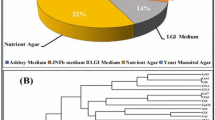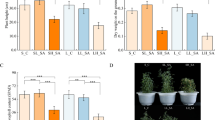Abstract
Crop production may benefit from plant growth-promoting bacteria. The knowledge on bacterial communities is indispensable in agricultural systems that intend to apply beneficial bacteria to improve plant health and production of crops such as canola. In this work, the diversity of root bacterial communities associated to two different developmental phases of canola (Brassica napus L.) plants was assessed through the application of new generation sequencing technology. Total bacterial DNA was extracted from root samples from two different growth states of canola (rosette and flowering). It could be shown how bacterial communities inside the roots changed with the growing stage of the canola plants. There were differences in the abundance of the genera, family, and even the phyla identified for each sample. While in both root samples Proteobacteria was the most common phylum, at the rosette stage, the most common bacteria belonged to the family Pseudomonadaceae and the genus Pseudomonas, and in the flowering stage, the Xanthomonadaceae family and the genus Xanthomonas dominated the community. This implies in a switch in the predominant bacteria in the different developmental stages of the plant, suggesting that the plant itself interferes with the associated microbial community.




Similar content being viewed by others
References
Lynch JM (1990) Longevity of bacteria—considerations in environmental release. Curr Microbiol 20:387–389
Roesch LF, Fulthorpe RR, Riva A, Casella G, Hadwin AKM et al (2007) Pyrosequencing enumerates and contrasts soil microbial diversity. ISME J 1:283–290
Torsvik V, Goksoyr J, Daae FL (1990) High diversity in DNA of soil bacteria. Appl Environ Microbiol 56:782–787
Duineveld BM, Rosado AS, van Elsas JD, van Veen JA (1998) Analysis of the dynamics of bacterial communities in the rhizosphere of the chrysanthemum via denaturing gradient gel electrophoresis and substrate utilization patterns. Appl Environ Microbiol 64:4950–4957
Hartmann A, Assmus B, Kirchhof G, Schloter M (1997) Direct approaches for studying soil microbes. In: van Elsas JD, Trevors JT, Wellington EMH (eds) Modern soil microbiology. Dekker, New York
Liesack W, Janssen PH, Rainey FA, Ward-Rainey NL, Stackebrandt E (1997) Microbial diversity in soil: the need for a combined approach using molecular and cultivation techniques. In: van Elsas JD, Trevors JT, Wellington EMH (eds) Modern soil microbiology. Dekker, New York
Amann RI, Ludwig W, Schleifer KH (1995) Phylogenetic identification and in situ detection of individual microbial cells without cultivation. Microbiol Rev 59:143–169
Ludwig W, Strunk O, Klugbauer S, Klugbauer N, Weizenegger M et al (1998) Bacterial phylogeny based on comparative sequence analysis. Electrophoresis 19:554–568
Rappe MS, Giovannoni SJ (2003) The uncultured microbial majority. Annu Rev Microbiol 57:369–394
Sogin ML, Morrison HG, Huber JA, Mark Welch D, Huse SM et al (2006) Microbial diversity in the deep sea and the underexplored “rare biosphere”. Proc Natl Acad Sci U S A 103:12115–12120
Dethlefsen L, Huse S, Sogin ML, Relman DA (2008) The pervasive effects of an antibiotic on the human gut microbiota, as revealed by deep 16S rRNA sequencing. PLoS Biol 6:e280
Huse SM, Dethlefsen L, Huber JA, Welch DM, Relman DA, et al (2008) Exploring microbial diversity and taxonomy using SSU rRNA hypervariable tag sequencing. Plos Genetics 4
Huse SM, Huber JA, Morrison HG, Sogin ML, Mark Welch D (2007) Accuracy and quality of massively parallel DNA pyrosequencing. Genome Biology 8
Tomm GO (2000) Situação atual e perspectivas da canola no Brasil. Comunicado Técnico On-line, 58. Passo Fundo: Embrapa Trigo
Germida JJ, Siciliano SD, de Freitas JR, Seib AM (1998) Diversity of root-associated bacteria associated with held-grown canola (Brassica napus L.) and wheat (Triticum aestivum L.). FEMS Microbiol Ecol 26:43–50
Kloepper JW, Lifshitz R, Schroth MN (1988) Pseudomonas inoculants to benefit plant-production. Isi Atl Sci-Anim Pl Sci 1:60–64
Siciliano SD, Goldie H, Germida JJ (1998) Enzymatic activity in root exudates of Dahurian wild rye (Elymus dauricus) that degrades 2-chlorobenzoic acid. J Agric Food Chem 46:5–7
Dunfield KE, Germida JJ (2003) Seasonal changes in the rhizosphere microbial communities associated with field-grown genetically modified canola (Brassica napus). Appl Environ Microbiol 69:7310–7318
Farina R, Beneduzi A, Ambrosini A, de Campos SB, Lisboa BB et al (2012) Diversity of plant growth-promoting rhizobacteria communities associated with the stages of canola growth. Appl Soil Ecol 55:44–52
Soares RA, Roesch LFW, Zanatta G, Camargo FAO, Passaglia LMP (2006) Occurrence and distribution of nitrogen fixing bacterial community associated with oat (Avena sativa) assessed by molecular and microbiological techniques. Appl Soil Ecol 33:14
Felske A, Engelen B, Nubel U, Backhaus H (1996) Direct ribosome isolation from soil to extract bacterial rRNA for community analysis. Appl Environ Microbiol 62:4162–4167
Brosius J, Palmer ML, Kennedy PJ, Noller HF (1978) Complete nucleotide sequence of a 16S ribosomal RNA gene from Escherichia coli. Proc Natl Acad Sci U S A 75:4801–4805
Sun Y, Cai Y, Liu L, Yu F, Farrell ML et al (2009) ESPRIT: estimating species richness using large collections of 16S rRNA pyrosequences. Nucleic Acids Res 37:e76
Wang Q, Garrity GM, Tiedje JM, Cole JR (2007) Naive Bayesian classifier for rapid assignment of rRNA sequences into the new bacterial taxonomy. Appl Environ Microbiol 73:5261–5267
Lancashire PD, Bleiholder H, Vandenboom T, Langeluddeke P, Stauss R et al (1991) A uniform decimal code for growth-stages of crops and weeds. Ann Appl Biol 119:561–601
Costacurta A, Vanderleyden J (1995) Synthesis of phytohormones by plant-associated bacteria. Crit Rev Microbiol 21:1–18
Khalid A, Arshad M, Zahir ZA (2004) Screening plant growth-promoting rhizobacteria for improving growth and yield of wheat. J Appl Microbiol 96:473–480
Beneduzi A, Peres D, da Costa PB, Bodanese Zanettini MH, Passaglia LM (2008) Genetic and phenotypic diversity of plant-growth-promoting bacilli isolated from wheat fields in southern Brazil. Res Microbiol 159:244–250
Beneduzi A, Peres D, Vargas LK, Bodanese-Zanettini MH, Passaglia LMP (2008) Evaluation of genetic diversity and plant growth promoting activities of nitrogen-fixing bacilli isolated from rice fields in South Brazil. Appl Soil Ecol 39:311–320
McClinchey SL, Kott LS (2008) Production of mutants with high cold tolerance in spring canola (Brassica napus). Euphytica 162:51–67
Chavarria G, Tomm GO, Muller A, Mendonca HF, Mello N et al (2011) Leaf area index of canola under varying row spacing and plant density of sowing. Ciencia Rural 41:2084–2089
Di Cello F, Bevivino A, Chiarini L, Fani R, Paffetti D et al (1997) Biodiversity of a Burkholderia cepacia population isolated from the maize rhizosphere at different plant growth stages. Appl Environ Microbiol 63:4485–4493
Grayston SJ, Wang SQ, Campbell CD, Edwards AC (1998) Selective influence of plant species on microbial diversity in the rhizosphere. Soil Biol Biochem 30:369–378
Kaiser O, Puhler A, Selbitschka W (2001) Phylogenetic analysis of microbial diversity in the rhizoplane of oilseed rape (Brassica napus cv. Westar) employing cultivation-dependent and cultivation-independent approaches. Microb Ecol 42:136–149
Marschner P, Yang CH, Lieberei R, Crowley DE (2001) Soil and plant specific effects on bacterial community composition in the rhizosphere. Soil Biol Biochem 33:1437–1445
Kowalchuk GA, Buma DS, de Boer W, Klinkhamer PG, van Veen JA (2002) Effects of above-ground plant species composition and diversity on the diversity of soil-borne microorganisms. Antonie Van Leeuwenhoek 81:509–520
Mitchell RJ, Hester AJ, Campbell CD, Chapman SJ, Cameron CM et al (2010) Is vegetation composition or soil chemistry the best predictor of the soil microbial community? Plant Soil 333:417–430
Smalla K, Wieland G, Buchner A, Zock A, Parzy J et al (2001) Bulk and rhizosphere soil bacterial communities studied by denaturing gradient gel electrophoresis: plant-dependent enrichment and seasonal shifts revealed. Appl Environ Microbiol 67:4742–4751
Miller HJ, Henken G, Vanveen JA (1989) Variation and composition of bacterial-populations in the rhizospheres of maize, wheat, and grass cultivars. Can J Microbiol 35:656–660
Hozore E, Alexander M (1991) Bacterial characteristics important to rhizosphere competence. Soil Biol Biochem 23:717–723
Kloepper JW (1993) Plant growth-promoting rhizobacteria as biological control agents. Marcel Dekker, New York
Francis I, Holsters M, Vereecke D (2010) The Gram-positive side of plant-microbe interactions. Environ Microbiol 12:1–12
Marilley L, Aragno M (1999) Phylogenetic diversity of bacterial communities differing in degree of proximity of Lolium perenne and Trifolium repens roots. Appl Soil Ecol 13:127–136
Acknowledgments
We thank R. Luís Mayer Weber for his valuable scientific comments. The work from Brazilian side was financed by a grant and fellowships from the Conselho Nacional de Desenvolvimento Científico e Tecnológico (CNPq), Coordenação de Aperfeiçoamento de Pessoal de Nível Superior, and Instituto Nacional de Ciência e Tecnologia da Fixação Biológica do Nitrogênio. Work in the lab of VFW was supported in part by grant BRA 09/008 from the IB-BMBF Germany.
Author information
Authors and Affiliations
Corresponding author
Electronic supplementary material
Below is the link to the electronic supplementary material.
Table S1
Sequencing data for samples R1 and R2 (PDF 61 kb)
Rights and permissions
About this article
Cite this article
de Campos, S.B., Youn, JW., Farina, R. et al. Changes in Root Bacterial Communities Associated to Two Different Development Stages of Canola (Brassica napus L. var oleifera) Evaluated through Next-Generation Sequencing Technology. Microb Ecol 65, 593–601 (2013). https://doi.org/10.1007/s00248-012-0132-9
Received:
Accepted:
Published:
Issue Date:
DOI: https://doi.org/10.1007/s00248-012-0132-9




